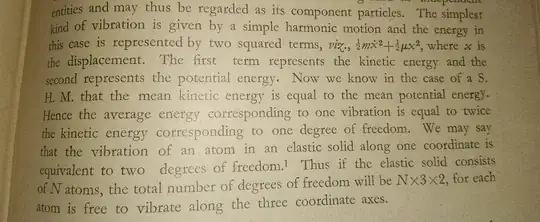I was reading a book on kinetic theory. In the part of equipartition theorem, I found a line as follows,
" The average energy corresponding to one vibration is equal to twice the K.E. corresponding to one degree of freedom."
I didn't really understand what it meant. Can anyone explain, please?
And another question. Why according to equipartition theorem a harmonic oscillator has two degree of freedom?
- 220,844
1 Answers
To fully describe the state of a harmonic oscillator you need to input two numbers: the position and the velocity. The degrees of freedom are how many parameters can vary during the evolution of the system. When a harmonic oscillator oscillates the position and velocity generally take on different values, while the mass stays constant. So the mass doesn't count towards the degrees of freedom.
You can also use other variables to describe your system. Take as a weird example $f(x,v)=e^{ax+bv}$, $g(x,v)=e^{ax-bv}$. Whatever you choose you still have to specify two variables to describe the system. The DOF doesn't depend on your choice of coordinates.
As an example let's extend the harmonic oscillator to two dimensions so it has energy $$H=\frac 1 2 m(\dot x^2+\dot y^2)+\frac 1 2\mu(x^2+y^2)$$ You can count the DOF: you need to specify $x,y,\dot x,\dot y$ to fully specify the state. For the equipartition you need additionally that the DOF appears as a square in the energy for it to count toward the equipartition theorem. Since each of these variables appears as a square so you get 4 times $\frac 1 2k_B T$ for the average energy.
- 19,613